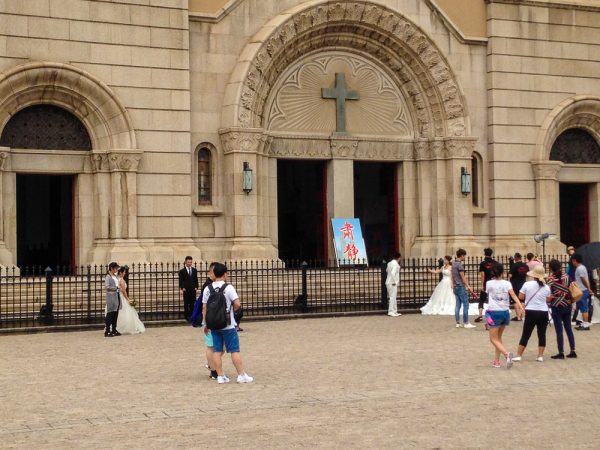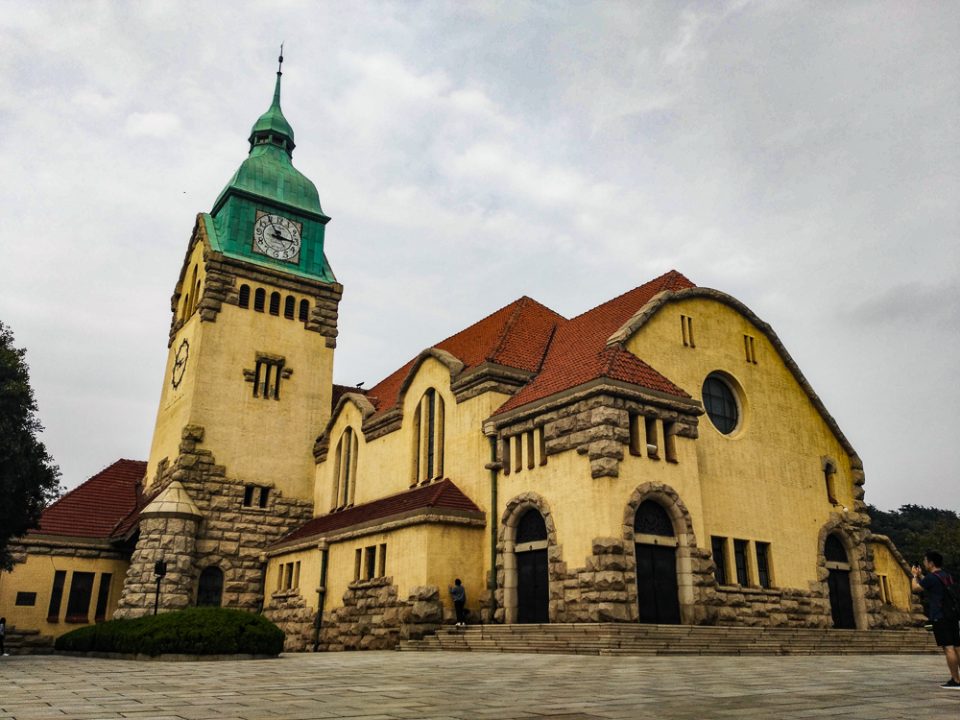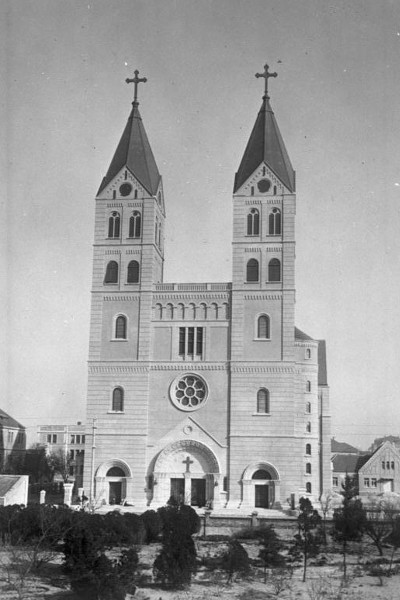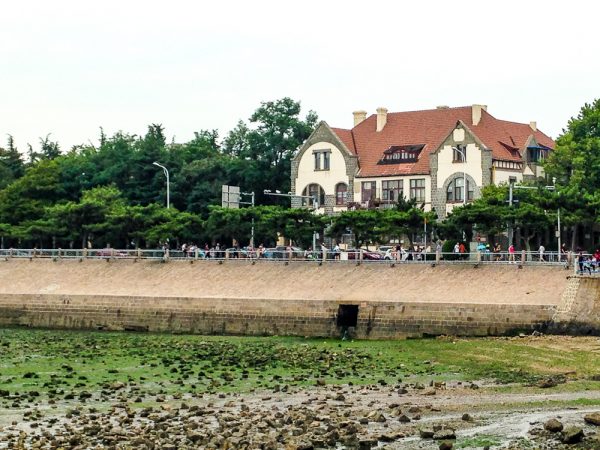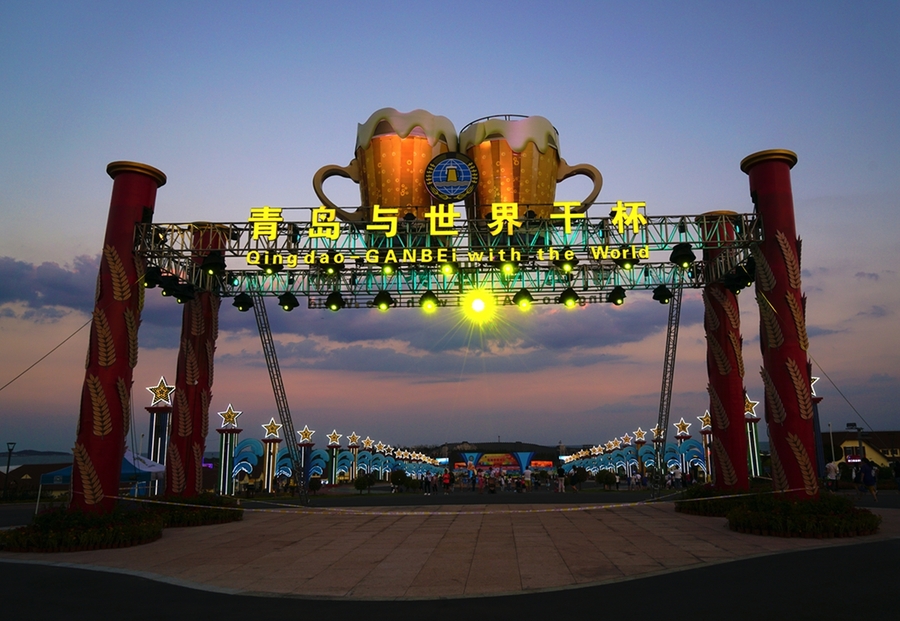Exploring Qingdao’s Long Lost German Colonial Town
Published by CamDarling on
I finished off my 30 days in China in Qingdao, a city that wasn’t really on my radar and travel itinerary until I found a cheap flight to Fukuoka, Japan. To my delight, I discovered Qingdao’s beautiful heritage still visible today in the German Architecture and Festivals like the Annual Beer Festival that takes place every summer on Golden Beach.
Qingdao doesn’t have a rich ancient history, it was a simple fishing village until the German’s turned it into their model colony and naval port. The German’s brought buildings, roads, technology and industry to part of the world that had never seen things like street lamps and in house plumbing before. The German’s even built up facilities around the beaches for the settlers and sailors to enjoy. Those same beaches offer tourist today the opportunity to soak in some sun and swim in the Yellow Sea. Walking along the boardwalk, admiring the old town and sights, you can see the influence of Germany’s small colony from over 100 years ago.
St. Michael’s Cathedral
The mid 20th century in China was the time of the red revolution, rise of Mao and the communist party of China. Today, China is more open to the world in some respects including tourism, business, culture, fashion and innovation. But freedom of religion remains a contentious issue which is strange to think about while standing in front of a German built Church in China from 1934.
St. Michael’s Cathedral is reminder of a time when China’s isolation ended. In our Beijing article we covered the Opium Wars and the treaty that resulted in opening up ports to foreign powers. Well Qingdao was Germany’s port in what was then called the “Jiazhou Bay Concession”.
The German’s took the small town in 1897 under the pretext that two missionaries were killed by a mob of Chinese peasants, and the Qing “agreed” to a 99 year lease. They took an area of 540 sq. kms by forcibly relocating all the local farmers and fishermen. In what was once a small rural village rose a true European town with a main street. Brick buildings, electricity, a sewer system, clean water wells, and the most schools per capita of anywhere in China.
The cathedral has a long rich history, changing hands again and again between the Chinese-Germans, Japanese Imperialist during WW1 and WW2, and Communist Chinese. Before the red revolution in the 1950s and 60s, the foreign missionaries of the Roman Catholic church ran the Qingdao Diocese directly under the directives of the Vatican in Rome. After the revolution, the Chinese re-opened and restored the abandoned church under the “Chinese Patriotic Catholic Association” that takes directives from the Communist Part of China, as if the name didn’t give it away.
The Cathedral is one of the central features of Qingdao, a heritage site and popular place for Wedding Photos! There were at least 4 brides in white dresses taking photos during my visit.
Protestant Church – Jidu Jiaotang
Another legacy of Germany’s presence in Qingdao is the Prostant Church designed by German Curt Rothkegel in a medieval style.
The church has a beautiful clock tower and still uses the original bells. Unlike St. Michael’s Cathedral, few outside of Qingdao knew this was a church and it was spared the pillaging of the communist red guards during the red revolution.
Many modern buildings in Qingtao were inspired by the few remaining German Colonial ones and it has become part of the city’s identity and popular among both Chinese and international tourists.
German Governor’s Residence Museum
The German’s had originally taken Qingdao in the idea of making a permanent colony and naval base in imitation of Britain’s successful colonization efforts in the region. After securing the 99 year lease in 1998, the German’s appointed Carl Rosendahl as the first Governor. The Governors were always Naval Officers but were also charged with administering civilian life in Qingdao to make it the perfect “Model colony”. The First Leader of China after the 1911 fall of the Qing Dynasty, Sun Yat-sen called the small town “A true model for China’s future”.
A bank was opened, the once the railroad was completed, it was possible to travel by train from Qingdao to Berlin via the Trans-Siberian. This is still possible today! The German’s lost control of the Qingdao settlement in 1914 when the Japanese, allied with the British, laid siege to the naval base. The League of Nations agreed to let other nations take control of German colonies after WW1. Japan tried to assume the remainder of the 99 year lease but eventually returned the colony to China in 1922.
In an ironic twist, Mao Zedong stayed at the Governor’s Residence in 1958 with his family, all while eradicating western ideologies, imprisoning foreigners and destroying other buildings. Mao too, couldn’t resist the lovely German architecture that cost 2.5 million silver taels when it was constructed. The German Villa was converted to a Guest House in 1934 for visiting Military Officials and Politicians of the Republic of China.
Qingdao Beaches
Qingdao is one of the few places in China where tourists can enjoy a clear, clean and refreshing jump into the Yellow Sea. The city. although a little hazy some days, enjoy a nice temperature in the summer, perfect for a beach day!
In the gallery above, you can see 2nd Beach in the early 1900s with the German Sailors in white. That spot remains one of the best places in the city to soak in some sun! But here is a list of the other great beaches in Qingdao!
- Golden Beach – Huangdao
- Qingdao Shilaoren Beach & Diaosu Park (Near Qingdao University)
- No. 1 Bathing Beach & 2nd Beach
- Qingdao Beach & Zangqiao Pier
My friend Hui Ling went to Qingdao University near Shilaoren Beach and really recommends it. The beach is enormous and likely to be less chaotic on a busy summer day than the beaches downtown. You can take the #321 bus from downtown or a taxi for 20-30 RMB ($5-7 USD).
Zangqiao Pier
Qingdao made it onto my itinerary because I found a cheap flight to Fukuoka, Japan. Regretfully, I didn’t have a lot of time to explore Qingdao, only two days which were smoggy out and not nearly as hot as my days in Dalian. On my second day, I took an afternoon to walk downtown and visit the beach at Zongqiao Pier.
Looking straight ahead down the pier towards the town is where the German settlement used to be located. Many of the streets have been renamed but the original layout can still be seen on maps, especially around Guanhaishan Park only a 15 minute walk from the waterfront.
Despite the weather, it was very crowded! Crowded for me I should say. The boardwalk on the edge of the harbor is a wonderful place to walk and explore. The pier offers a 360 degree view of the surrounding city and beach. But if you continue walking east around the harbor towards the Naval Museum you’ll reach a long bridge to my favorite little island: “Small Qingdao”. It’s a cute little park, no busy at all and filled with beautiful statues.
Qingdao Beer Fest & Street Food
Qingdao celebrated its 100th anniversary as a city in 1991 by creating a 2 week festival that beer, drinking games, and fabulous concerts and performances. Since its first year, the festival has becoming the largest beer festival in Asia and lasts for over a month!
The event is located on Golden Sands beach, but festivities and events can also be located across the city anytime from the opening day July 20th, to the closing day August 26th. There are over 200 beer brands at the festivals from around the world and the entire festival as a very German theme to it, earning it the name Asia’s Oktoberfest! Complete with unlimited beer steins, beautiful women in dresses and of course, lederhosen!
Tsingtao Beer Brewery Museum
Qingdao, with its many German heritage buildings and modern day inspirations, is home to China’s first Beer Museum! Tsingtao Brewery Company was first established as a German Beer Company in 1903 by the settlers in the German colony. They brought German technology halfway around the world to brew a little taste of home.
The museum was built on the old site of the original brewery with a mix of Chinese and German architectural styles in 2002 and unveiled at the 100th anniversary of Tsingtao Beer in 2003. There is a tasting service and gift shop on the main floor while the museum showcases all the old machinery and ingredients such as barley, malts and hops. This is a great little tour to enjoy while exploring the international beer street nearby!
- Hours: 8:00 am to 6:00 pm July to September, 8:30 am to 5:30 pm October to June.
- Fee: 60 RMB July to September, 50 RMB October to June.

Tsingtao beer is a light lager, it’s one of the largest and most popular beers in China but many westerners find it a little light, like American Beer *Zing*. But it’s perfect on a 32 degree day in China!
Qingdao Street Food
Walking towards downtown from my Hostel and on the way to St. Michael’s Cathedral I stumbled upon this little narrow street packed with food stalls and little shops. I actually had a hard time finding the street again because its so small and isn’t listed anywhere online. I found a post on Tripadvisor and someone has called this “Eat Street” which I liked so let’s call it that too! The real name is Jiangning Road off a main road called Zhongshan Road.
Eat Street is this alley filled tightly with awesome shops, you can get almost any kind of food on a stick, ever since Malaysia I love food on a stick. I call them “stick stalls“. You pay based on the stick color and the number of sticks you choose! They also have these delicious frozen yogurt bowls for $2 that you simply have to try!
Qingdao Hostels
Located right downtown within walking distance to the peer, local shops, restaurants and more. Really basic bunk dorm rooms. The hostel was yet another old church which is cool and part of the unique history of Qingdao. Great social atmosphere as one of the most popular hostels in the city. That being said, Qingdao is more popular among local Chinese tourists than internationals.
For more hostel recommendations, check out our article the Best Hostel for China. It’s a master list of all the most popular hostels in 15 cities across China.
Getting to Qingdao
Walking around downtown Qingdao along the nice boardwalks was very enjoyable and offers a nice break from some of the busy streets further in town. But you are going to be walking around all day, I recommend having a few markers on your map for reference.
In the center of downtown only a few blocks from the beach is the main Railway Station. On the corner is a McDonald’s where you can get a bite and Wi-Fi. Outside the McDonald’s to the right is a series of bus stops that will take you almost anywhere you need to go!
Large long-distances buses stop in downtown every morning headed for the International Airport and North Railway Station. One bus to the airport stops in front of St. Michael’s Cathedral.
More Info on China
Traveling in China can be a challenge due to the language barrier and internet censorship. Check out the Best VPNs for China so you can use Google Maps, Instagram and Facebook, plus any of these Apps we recommend for China. And consider pick up a SIM Card for cheap to share all those awesome moments live with friends.
We know researching for a trip can be tedious. So we put together a List of Books, Movies and Podcasts to get you in the mood for travel to China. Check it out under Books & Things.
If you haven’t read our article on The Great Wall or The Forbidden City, we dived into different Dynasties and important characters in Chinese history. We also explored the dark history of the Opium Wars at The Summer Palace and the Chinese Hero Qi Jiguang who guarded The Great Wall.





